|
Staggering results: Monopole wind testing identifies overly conservative design calculations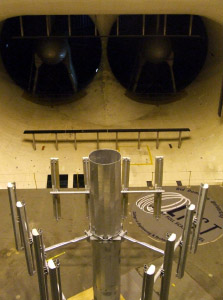
By Brad Cook, P.Eng.
September 26, 2007 - With the continuous growth in the wireless industry, there has been a demand to continually upgrade existing tower structures, pushing them to their limit, while just satisfying the latest structural TIA and IBC code requirements.
For guyed and self supporting towers, the analysis procedure has been time tested and upgrades routine; however, for monopoles, being fairly new to the tower industry (last 15 years), this has not been the case.
There has been wind tunnel testing on monopoles and various types of individual antennas but no known testing has been completed to date on the effects of wind around full platform arrays with and without antennas (degree of shielding), along with transmission lines and reinforcements banded up the outside of monopoles (change in drag coefficients). With no prior information readily available, it has been the engineer’s discretion on how to treat such cases until now.
|
PCIA Orlando seminar to explore prevention of structural failures
Brad Cook will be a guest panelist at a PCIA presentation at the association's annual conference in Orlando, FL on Thursday, October 4 from 10:00 a.m. until 11:15 a.m.
He'll be joined by David Brinker, Bill Garrett, Bill Griswold, Jim Kyriacopoulos, Chris Mallon, and Jim Hopkins who will discuss new standards and innovative techniques for the prevention of structural failures.
These expert engineers will discuss TIA-EIA Revision G, focusing upon how the new standard has changed load carrying capacity.
The panel will also turn its attention to testing cracks on monopole sections and how base plate design modifications can prevent future problems. Conference details for the wireless infrastructure show are available here .
|
On January 17 through 20, 2006, Structural Components completed the first ever full scale wind tunnel testing on various 20-foot monopole sections, mounts, as well as transmission lines and structural reinforcements attached up the outside of poles to help understand the true behavior of wind flow and drag. The objective: to gain accuracy and confidence in the structural analysis of monopoles with all the various appurtenances being added to them.
The full scale wind tunnel testing was completed at a 60-foot wide by 30-foot tall open wind tunnel facility at Langley Full Scale Testing (LFST) in Hampton, VA. Wind speeds ranged from 35 mph (just after subcritical flow) to upwards of 75 mph (supercritical flow). The testing was attended by major tower owners, tower manufacturers and consulting engineers.
Results contradict current design calculations
The first group of tests were conducted on various types of mounts from large triangular platforms with flat channel fronts and handrails (below photo) to low profile T-Arms with and without grating. These tests were subjected to wind speeds of up to 75 mph in turbulent flow conditions. With a rotating floor, wind directions from 0 degrees to the apex of platforms through 60 degrees were tested to find the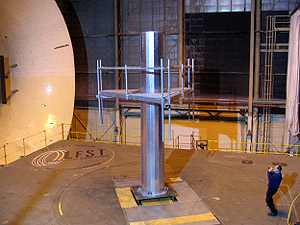 worst case scenarios (highest drag coefficients). worst case scenarios (highest drag coefficients).
Results: The results were staggering. With no handrails, platforms did not exceed a maximum CaAa wind area of 12.37 ft2 regardless of type. This contradicts what the tower industry has been using to date with varying CaAa values from 15 ft2 for low profile T-Arms to 45 ft2 for full flat-front platforms with hand rails.
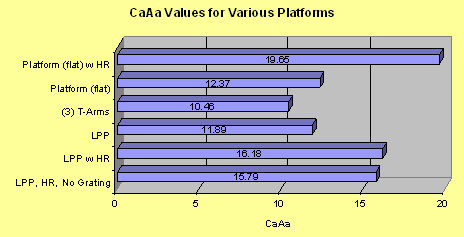 |
|
T-Arms and panel quantities varied in second test groups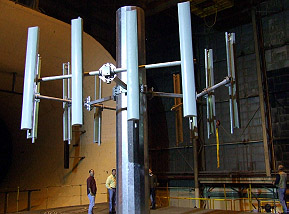
The second group of tests consisted of varying panel quantities and configurations on low profile T-Arms to determine how much shielding is being generated as well as overall drag coefficients.
Results: The results were again staggering. With a (12) panel configuration (at right), there was a significant amount of shielding that has typically been ignored to date in structural analysis. Where typical CaAa values of up to 105 ft2 would be used for (12) 8’ x 1’ panels on (3) low profile T-Arms, a CaAa of only 37 ft2 was calculated, resulting in a 65% reduction in the applied wind force.
|
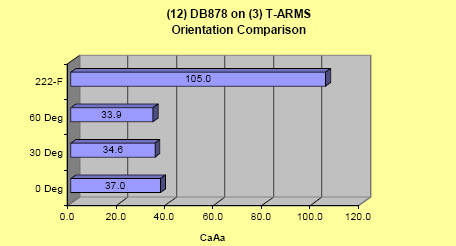 |
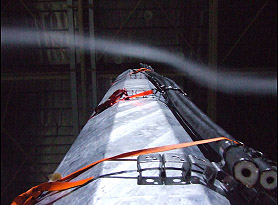
Transmission lines may exceed current designs used
The third group of tests consisted of varying quantities and orientations of transmission line cables up the outside of monopoles.
This has always been a big question in the engineering community on what effects, if any, transmission lines have with respect to drag factors of existing monopoles?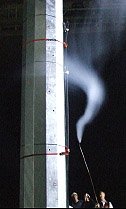
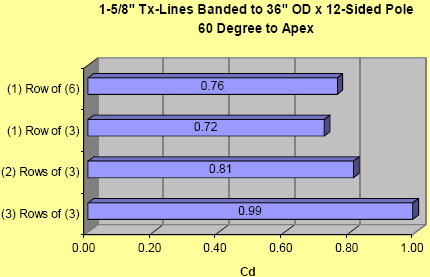
Results: Transmission lines have a huge impact on the drag factor of monopoles and in many cases, greatly exceeding current design estimates engineers commonly use today.
From our testing and the tables outlined above, transmission lines can definitely NOT be ignored in determining the overall wind load on structures and foundations.
The below (2) graphs can be linearly interpolated to help determine the appropriate drag factors considered in structural analysis when transmissions are strapped to the outside of monopoles. |
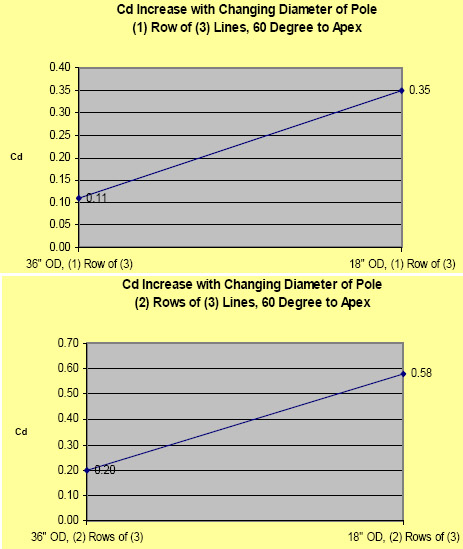 |
Overall drag factor impacted by reinforcements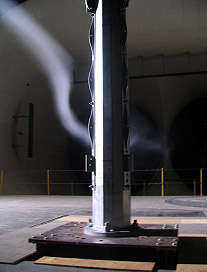
The last group of tests consisted of reinforcements up the outside of poles.
These tests were completed with bolt-on reinforcements bolted and strapped directly to the monopole. These photographs show Structural Components' LIGHT & HEAVY Series WAVE reinforcement systems.
Results: Reinforcements also have a large impact on the overall drag factor of monopoles. It is surprising to see that even a plate as small as ¾” thick increased the overall drag factor by more than 50%. This ¾” plate (under 10% of the overall width ratio) would currently be ignored in the TIA-222-G tower code. |
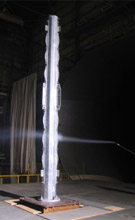 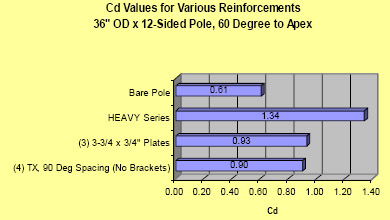 |
|
The last graph represents baseline tests on the drag factors (Cd values) of the five 20 ft. monopoles used for all testing. What is interesting to point out is how close the Cd values are between 12-sided and 18-sided poles. In the current TIA-222-F and the more recent 222-G tower code, a Cd value of 0.65 is used for 18-sided poles and 1.03 recommended for 12-sided poles representing a 58% increase in calculated wind on 12-sided pole structures.
|
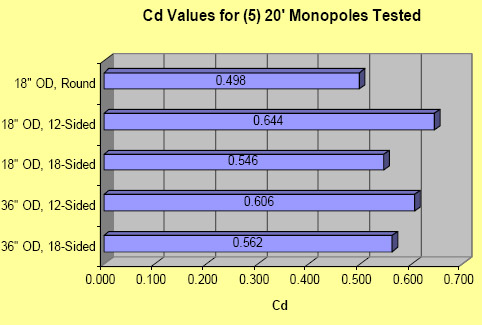 |
Exterior transmission lines relieve over-conservative calculations
Over the four day testing period, incredible data and insight has been obtained in understanding the affects of wind around monopoles as each appurtenance is added. Where we tend to be over conservative in calculating projected wind areas on antenna platforms and mounts (CaAa values), we make up when we start adding transmission lines and reinforcements to the outside of monopoles! |
More information on our test results is available upon request depending on the applications. We hope that this work will eventually find its way into the TIA tower standards of tomorrow. |
 Brad Cook is Vice President of Engineering for Structural Components LLC , based in Boulder, CO. Brad currently oversees the engineering, design and testing of tower reinforcements.Over the past two years, Brad has spearheaded full scale wind tunnel testing of monopoles and full scale structural testing of monopole reinforcements, both firsts in the tower industry. He can be contacted at: bcook@structuralcomponents.net. Brad Cook is Vice President of Engineering for Structural Components LLC , based in Boulder, CO. Brad currently oversees the engineering, design and testing of tower reinforcements.Over the past two years, Brad has spearheaded full scale wind tunnel testing of monopoles and full scale structural testing of monopole reinforcements, both firsts in the tower industry. He can be contacted at: bcook@structuralcomponents.net. |
| |
T-T-Arms
|